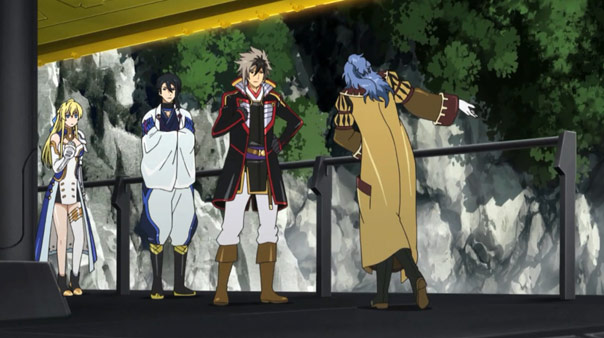In this day and age, the word “epic” is exceptionally overused (there’s even a nondenominational Epic Church in our neighborhood), and we’re just as guilty as the rest of society, but in the case of the story rapidly unfolding in Nobunaga the Fool, we feel the term is apt. After a somewhat breathless introduction, things are allowed to settle down a bit, but the fact remains a grand adventure is afoot, one that will shape the future of the Eastern and Western Stars.
Once Nobu has successfully translated his not insignificant combat skills in operating da Vinci’s newest war armor, he and Jane formally meet, and while things get off to a somewhat bellicose start, things simmer down with da Vinci as affable moderator laying out the scenario. He believes Nobu to be the “savior-king” of the East, and lends him the use of his masterpiece (which Nobu christens “The Fool” or “Za Fuuru”) that he may show him the “truth of the universe.”

Da Vinci has already risked quite a bit to get to where he is, but he strikes us as a man of singular conviction; he has faith that the universe will show him what he wants to see, thanks to the equally extraordinary individuals he chooses to consort with. He’s regarded as perhaps the finest mind of his world, and that world believes he’s defected, so it’s good that he’s met powerful, charismatic new friends.
Nobunaga comes off as a bit of a cocky show-off at times, but never annoyingly, Naruto-ingly so. He doesn’t appear to be that much of a chauvinist, either; that trait is reserved for Toyotomi “Saru” Hideyoshi, who seems to think ogling Jeanne’s bust and grabbing her golden locks is appropriate behavior for an adult (Akechi Mitsuhide is more refined, while Nobu falls between the two in personality). Nobunaga simply warns Jeanne as he’d warn any man, not to draw a blade again unless she intends to take a life with it. We only see him interact with his sister Ichihime for a moment, but it looks like he holds her esteem; such that he insists Jeanne hide herself lest Ichi get the wrong idea.
There’s a rooted logic and equity to the alliance of da Vinci, Nobu, and Jeanne that forms this week. One seeks answers he can’t get anywhere else; one seeks the power to defeat his foes; and one seeks her destiny, a venture Nobu scoffs at, because ‘why trust your fate to strangers?’ His skepticism aside, the fact da Vinci draws the same cards the episodes are named after indicates that even Nobu isn’t entirely free from destiny’s embrace.
Jeanne’s quest may intrigue us the most, since its true nature is as inscrutable to her as it is to us. She only knows Nobu just might be the right person to help her find it, coarse and bloodthirsty a fellow as he may initially seem. She may not come to love the guy, but mutual respect and cooperation are in order.

Rating: 8 (Great)
Stray Observations:
- While pulling a dagger on Nobu in such an awkward position probably wasn’t prudent, Jeanne can clearly take care of herself, as evidenced by the punitive blow she delivers to Saru.
- There’s an Eastern girl with two-tone hair voiced by Touyama Nao who’s looking forward to meeting Nobu. Wonder what that’s about.
- In addition to the Armor, da Vinci also gifts Nobu with an intricate clock of his own design…which Nobu immediately re-gifts for his brother’s coming-of-age ceremony.
- Historical figures gathered round the, er, Round Table include Gupta, Hannibal, Alexander, and Julius Caesar. It’s like Civilization: The Animation!


